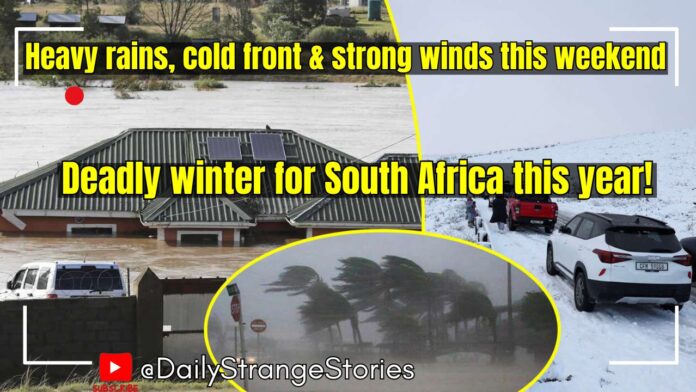The winter of 2025 is proving to be a formidable adversary for South Africa. As July begins, the nation is bracing itself for a series of intense weather systems that promise to deliver a trifecta of hardship: heavy rains, biting cold, and fierce winds. These conditions are not merely an inconvenience; they pose a significant threat to lives and livelihoods across several provinces. From the vineyards of the Western Cape to the high-altitude peaks of the Drakensberg, communities are preparing for what could be a particularly challenging few days.
The South African Weather Service (SAWS) has been issuing warnings since the beginning of the week, painting a picture of a country under siege from the elements. A succession of cold fronts is expected to sweep across the land, starting on Thursday 3 July 2025 and continuing through the weekend. The initial impact will be felt most acutely in the Western and Northern Cape, but the effects are predicted to ripple outwards, touching parts of the Free State and Eastern Cape as well.
Rain is expected to be a constant companion throughout this period. On Thursday 3 July 2025, the odds of rainfall vary across the country, from a 30% chance of isolated showers in parts of the Northern Cape to a more substantial 60% chance of scattered rain across the central interior, including Bloemfontein and Aliwal North. However, it is the south-western coastal regions that are expected to bear the brunt of the downpour, with an 80% chance of widespread rain in areas like Worcester and its surroundings.
The approaching cold fronts are not just bringing rain; they are also ushering in strong winds, particularly along the south-west coast. On Friday 4 July 2025, gusts are predicted to reach speeds of up to 80 kilometers per hour between Saldanha Bay and Cape Agulhas. These powerful winds have prompted SAWS to issue a yellow level 2 warning, indicating a moderate risk of impact. The combination of strong winds and heavy rain could make conditions treacherous, especially for those at sea or in coastal areas.
As Friday 4 July 2025 progresses, the cold air is expected to penetrate further inland, bringing with it the possibility of snow. The high peaks of the Eastern Cape and the southern Drakensberg regions could see a dusting of white, transforming the landscape and adding another layer of complexity to the already challenging weather conditions.
The rainfall probabilities remain high on Friday 4 July 2025, with a 60% chance of scattered rain across southern interior areas and a 30% chance of isolated showers extending towards the Free State and southern KwaZulu-Natal. This widespread precipitation raises concerns about potential flooding, particularly in areas where the ground is already saturated from previous rainfall.
The weekend offers little respite, with another cold front expected to arrive in the Western Cape on Sunday 6 July 2025. This front is predicted to bring further showers and strong south-westerly waves, measuring between 4.5 and 5.5 meters, between Cape Agulhas and Plettenberg Bay. These waves, combined with wave periods of 10 to 12 seconds, could pose a significant hazard to maritime activities and coastal communities.
The cumulative effect of these weather systems has prompted SAWS to issue multiple impact-based warnings. A yellow level 4 warning is in effect for disruptive rainfall in the Western Cape from Thursday 3 July 2025 to Sunday 6 July 2025. This warning highlights the potential for flooding of roads and low-lying areas, danger to life from fast-flowing streams, and potential disruptions to essential services.
The combination of persistent rain and already saturated soils is a major cause for concern. The ground's ability to absorb further rainfall is severely compromised, increasing the risk of flash floods and widespread inundation. Communities living in low-lying areas are particularly vulnerable and are urged to take precautions to protect themselves and their property.
The interior of the Western Cape and the southern parts of the Namakwa district in the Northern Cape are bracing for very cold, wet, and windy conditions. Light snowfall is even possible on the mountain peaks, adding to the challenges faced by residents in these areas. SAWS has specifically advised the public and small stock farmers to take necessary precautions to ensure the safety and health of animals during these harsh conditions. Livestock are particularly vulnerable to the cold and wet, and farmers are urged to provide adequate shelter and ensure they have sufficient feed.
The approaching cold fronts are expected to cause a sharp drop in temperatures across the central interior. This temperature plunge will bring rain to parts of the Free State, Eastern Cape, North West, and Western Cape, further exacerbating the already difficult conditions.
The freezing levels are also expected to drop significantly by Friday 4 July 2025, raising the possibility of snowfall in the Drakensberg mountains and even sleet over the southern parts of Gauteng. While snow may be a welcome sight for some, it can also cause significant disruptions, particularly in mountainous areas where roads may become impassable.
Damaging winds are expected to be localized over parts of the central and southern Northern Cape. These winds could cause damage to settlements and temporary structures, disrupt transport and travel services, and even lead to falling trees. Residents in these areas are advised to secure loose objects and take extra caution when traveling.
The disruptive rain is expected to be concentrated in the extreme southwestern parts of the Western Cape, including Cape Town and the West Coast. This could lead to localized flooding, particularly in areas with poor drainage. City of Cape Town officials are on high alert and are coordinating responses to the anticipated impacts.
While the Western Cape is expected to bear the brunt of the initial onslaught, other provinces are also bracing for challenging conditions. Gauteng, for example, is expected to experience a partly cloudy day with cold temperatures and a 30% chance of showers and rain over the southern parts of the province.
The potential for veld fires is also a concern, particularly in the southwestern parts of the Free State, the western parts of the North West, and the northern parts of the Eastern Cape. Damaging winds in these areas could create conditions conducive to the rapid spread of fires, posing a threat to both property and lives.
Looking ahead to the weekend, Gauteng is expected to be cold with partly cloudy conditions on Saturday 5 July 2025, especially in the northern parts of the province. On Sunday 6 July 2025, there is a 30% chance of showers and thundershowers, mainly over the southern parts of the province.
The Eastern Cape is also expected to experience snowfall over the high-lying areas, potentially causing disruptions, especially in the mountainous regions around the Trunk and Speck mountains on Sunday 6 July 2025.
By Monday 7 July 2025, conditions are expected to start clearing over most parts of the central interior. Temperatures will begin to recover in the afternoon, but drizzles are expected in the escarpments of Mpumalanga and the eastern parts of Limpopo. There is also a 30% chance of showers and rain, mainly along the south coast into the east coast.
In response to the impending weather, the City of Cape Town's disaster risk management centre is coordinating responses to mitigate the impacts. They have also alerted NGO partners, who will provide humanitarian assistance where needed. Residents are urged to address any issues on their properties to reduce the risk of localized flooding and to report any city-related service requests.
The approaching cold fronts follow a week of persistent rain in the Western Cape, further saturating the ground and increasing the risk of flooding. The SAWS has warned that the rain could become disruptive, affecting various areas from the Cape Winelands to Cape Town and the West Coast.
A yellow level 1 warning for severe thunderstorms has been issued for the Eastern Cape, with the potential for large amounts of small hail, damaging winds, and excessive lightning.
This severe weather comes amid a particularly deadly winter season in South Africa. Recent events in the Eastern Cape and KwaZulu-Natal have highlighted the vulnerability of communities to extreme weather conditions.
Of the 102 bodies recovered, 96 have been identified and handed over to families, while six remain unidentified. The identification process has been complicated by the passage of time, with DNA tests potentially required for the identification of decomposed bodies. Among the deceased are 32 pupils, with a demographic breakdown of 49 men and 53 women, and 63 adults and 39 children.
In KwaZulu-Natal, nine people died over the weekend due to winter-related incidents. Seven men, aged 17 to 50, are suspected to have died from smoke inhalation in Pietermaritzburg after lighting a brazier (imbawula) for warmth. In a separate incident in eThekwini, two people died in an informal settlement fire that destroyed 13 structures.
These tragic events serve as a stark reminder of the dangers posed by extreme weather conditions and the importance of taking precautions to protect lives and property.
As South Africa braces itself for this latest winter onslaught, it is crucial that residents stay informed, heed official warnings, and take necessary precautions to mitigate the impacts of the severe weather. The combination of heavy rains, cold temperatures, and strong winds poses a significant threat, and it is only through collective action and preparedness that communities can weather this storm and emerge stronger on the other side. The situation in JOHANNESBURG remains tense as residents prepare for the worst, hoping that the coming days will not add to the already tragic toll of this deadly winter.
Given the severity of the situation and the potential impact on communities across South Africa, what steps do you think individuals and the government should prioritize to ensure the safety and well-being of those most at risk during this challenging winter period?

Follow Us on Twitter











